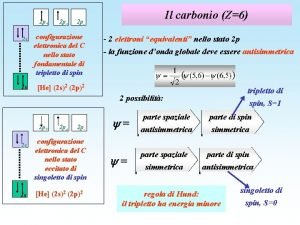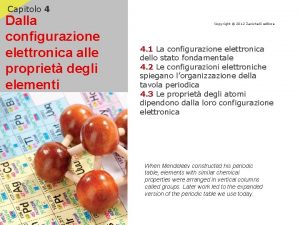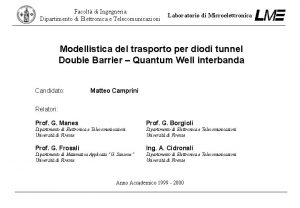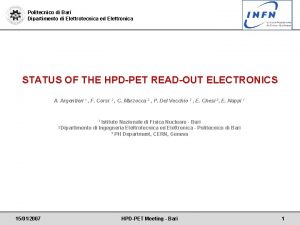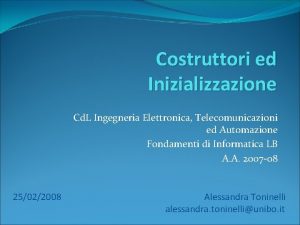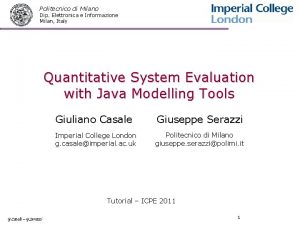OPTCOM GROUP DIPARTIMENTO DI ELETTRONICA E TELECOMUNICAZIONI POLITECNICO










![BP VS. T: FIX-GRID Blocking Probability [%] 30% 10% __ R G= 20 G BP VS. T: FIX-GRID Blocking Probability [%] 30% 10% __ R G= 20 G](https://slidetodoc.com/presentation_image/3ce9c56842152b8e0f84b9b847b3cc1e/image-11.jpg)
![BP VS. T: FLEX-GRID Blocking Probability [%] 30% 10% __ R G= 20 G BP VS. T: FLEX-GRID Blocking Probability [%] 30% 10% __ R G= 20 G](https://slidetodoc.com/presentation_image/3ce9c56842152b8e0f84b9b847b3cc1e/image-12.jpg)



- Slides: 15

OPTCOM GROUP DIPARTIMENTO DI ELETTRONICA E TELECOMUNICAZIONI POLITECNICO DI TORINO ITALY

MOTIVATION Btot Bstat Allocated bandwidth Supposed to be defragmented Bdyn Bandwidth available for dynamic spectral allocation Total available bandwidth • Most networks are running out of spectrum • New – and supposedly dynamic – traffic has to be allocated on the residual bandwidth • What is the advantage of flex- vs. fix-grid given the residual bandwidth? ICTON 2017, paper Th. B 4. 5 curri@polito. it 2

OUTLINE • The generalized OSNR as l Qo. T and the LOGO control plane and the statistical network assessment process (SNAP) • Residual bandwidth percentage • Traffic model • Fix- and fle-grid transceivers • The Italian network topology • Results as BP vs. Total allocated traffic • Comments and conclusions ICTON 2017, paper Th. B 4. 5 curri@polito. it 3

AN ALL OPTICAL TRANSPARENT NETWORK With the knoweledge of the network physical details D Example: Qo. T for lightpath travelling from node A to node G through nodes C and E: F E B A We set the optimal power per channel and manage the network as an inverse-OSNR (IOSNR) weighted graph G C H I ICTON 2017, paper Th. B 4. 5 where curri@polito. it 4

STATISTICAL NETWORK ASSESSMENT PROCESS i=i+1 Metrics’ evolution vs. j j=j+1 Traffic model i-th Monte Carlo run Start J-th Traffic request RWA algori thm Network description NO sat ura tion RWA NO YES I> NMC YES SNAP Network snap-shot @ i, j Network evolution storage Static Metrics M. Cantono et al. “Potentialities and Criticalities of Flexible-Rate Transponders in DWDM networks: a Statistical Approach , ” JOCN, 2016 V. Curri et. al. , “Elastic All-Optical Networks: a New Paradigm Enabled by the Physical Layer. How to Optimize Network Performances? , ” JLT, 2017 ICTON 2017, paper Th. B 4. 5 curri@polito. it 5

RESIDUAL BANDWIDTH PERCENTAGE (RBP) Bstat Allocated bandwidth Supposed to be defragmented Bdyn Bandwidth available for dynamic spectral allocation Btot: C-band • Total available bandwidth: C-band of 4000 GHz • RBP=Bdyn/Btot x 100 [%] • We consider three different scenarios 1. Lightly loaded network: RPB = 25% 2. Moderately loaded network: RBP = 50% 3. Heavily loaded network: RBP = 75% ICTON 2017, paper Th. B 4. 5 curri@polito. it 6

TRAFFIC MODEL • Any-to-any traffic • Flat probability in traffic requests • Traffic requests «groomed» at • RG = 20 Gbps • RG = 40 Gbps • RG = 100 Gbps • 5000 Monte-Carlo progressive network loading up to blocking probability BP of 30% • RSWA algorithm: shortest path up to kmax=50 ICTON 2017, paper Th. B 4. 5 curri@polito. it 7

FIX AND FLEX GRID TRANSCEIVERS Fix-grid Flex-grid f. LPi+1 f. LPi+2 f. LPi+3 f. LPi+4 f • WDM grid: Df =37. 5 GHz f • Grid: Df=RS, slot =12. 5 Gbaud, up to 5 slots • RS =31. 25 Gbaud • Coding overhead = 25% • fch tunable on 6. 25 GHz • Guard-band: = 6. 25 GHz • Guard-band = 6. 25 GHz Modulation Format Net Bit rate (R b) Gbps Modulation Format PM-BPSK 50 PM-QPSK Net Bit rate (R b) Gbps Ns=1 Ns=2 Ns=3 Ns=4 Ns=5 PM-BPSK 20 40 60 80 100 PM-QPSK 40 80 120 140 280 PM-16 QAM 200 PM-16 QAM 80 160 240 320 400 PM-64 QAM 300 PM-64 QAM 120 240 360 480 600 ICTON 2017, paper Th. B 4. 5 curri@polito. it 8

THE ITALIAN NETWORK TOPOLOGY ICTON 2017, paper Th. B 4. 5 curri@polito. it 9

RESULTS • Metrics • Normalized Network Traffic (T) is the total traffic loading the network normalized with respect the available bandwidth: it is indeed a specrat eexploitation efficiency • Blocking probability (BP): it is the probability that a new traffic request is rejected • Results are shown as BP vs. T for the different scenarios • Comparisons at BP = 1% are shown as well ICTON 2017, paper Th. B 4. 5 curri@polito. it 10
![BP VS T FIXGRID Blocking Probability 30 10 R G 20 G BP VS. T: FIX-GRID Blocking Probability [%] 30% 10% __ R G= 20 G](https://slidetodoc.com/presentation_image/3ce9c56842152b8e0f84b9b847b3cc1e/image-11.jpg)
BP VS. T: FIX-GRID Blocking Probability [%] 30% 10% __ R G= 20 G __ R G= 40 G __ R G=100 G 1% 0 … RBP= 25% _. _RBP= 50% _ _RBP= 75% 5 10 15 20 25 Normalized Network Traffic [Tbps/THz] ICTON 2017, paper Th. B 4. 5 30 35 curri@polito. it 11
![BP VS T FLEXGRID Blocking Probability 30 10 R G 20 G BP VS. T: FLEX-GRID Blocking Probability [%] 30% 10% __ R G= 20 G](https://slidetodoc.com/presentation_image/3ce9c56842152b8e0f84b9b847b3cc1e/image-12.jpg)
BP VS. T: FLEX-GRID Blocking Probability [%] 30% 10% __ R G= 20 G __ R G= 40 G __ R G=100 G 1% … RBP= 25% _. _RBP= 50% _ _RBP= 75% 0. 1% 0 5 10 15 20 25 Normalized Network Traffic [Tbps/THz] ICTON 2017, paper Th. B 4. 5 30 35 curri@polito. it 12

25 20 FIXED GRID FLEX GRID 15 11. 6 8. 8 10 5 16. 5 3. 6 4. 4 5. 0 0 25% 50% 75% Residual Bandwidth [%] RG = 40 Gbps 30 25 20 FIXED GRID 21. 1 24. 2 17. 3 15 10 7. 1 8. 7 9. 7 5 0 25% 50% 75% Residual Bandwidth [%] Normalized Network Traffic [Tbps/THz] RG = 20 Gbps 30 Normalized Network Traffic [Tbps/THz] FLEX VS. FIX @ BP=1% 30 25 20 RG = 100 Gbps FIXED GRID FLEX GRID 21. 2 24. 3 19. 2 15 10 5 0 25% 50% 75% Residual Bandwidth [%] • RBP=25% • RBP=50% • RBP=75% • Flex 2 Fix 2. 5 • Flex 2 Fix 3. 3 • Flex 2 Fix 2. 5 ICTON 2017, paper Th. B 4. 5 20. 2 16. 7 • RBP=25% • Flex 2 Fix 2. 5 26. 1 • Flex 2 Fix 1. 3 curri@polito. it 13

CONCLUSIONS • We showed that flex-grid is always advantageous with respect to fix-grid • The relative advantage that is around 2. 5 times for grooming sizes of 20 and 40 Gbps, decreases to 1. 3 times for RG= 100 Gbps because of saturation effects • Spread of spectral efficiency for different scenarios of RBP and RG is much smaller for flex-grid, while using fix-grid the larger RG, the better ICTON 2017, paper Th. B 4. 5 curri@polito. it 14

This work was supported by CISCO Systems within a SRA contract ICTON 2017, paper Th. B 4. 5 curri@polito. it 15
 Ipn escuela superior de economia
Ipn escuela superior de economia Edufacil como ingresar
Edufacil como ingresar Politecnico di torni
Politecnico di torni Sergio ilarri
Sergio ilarri Tartaglia triangolo
Tartaglia triangolo Logo politecnico bari
Logo politecnico bari Haggen dazz
Haggen dazz Angelo tartaglia politecnico torino
Angelo tartaglia politecnico torino Liceo politecnico ciencia y tecnologia
Liceo politecnico ciencia y tecnologia Liceo bicentenario politecnico de ovalle
Liceo bicentenario politecnico de ovalle Politecnico di torino rector
Politecnico di torino rector Promofarma fattura elettronica
Promofarma fattura elettronica Carbonio z=6
Carbonio z=6 Configurazione elettronica interna ed esterna
Configurazione elettronica interna ed esterna Configurazione elettronica lantanio
Configurazione elettronica lantanio L'energia di ionizzazione
L'energia di ionizzazione












